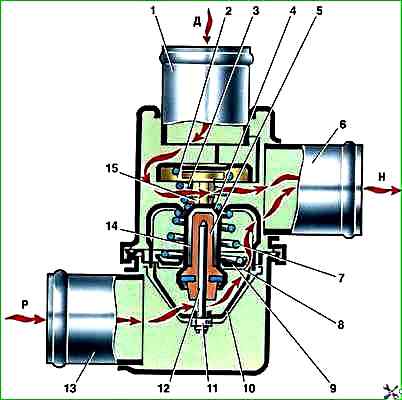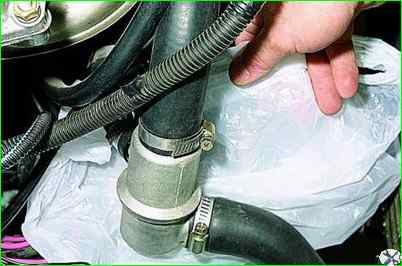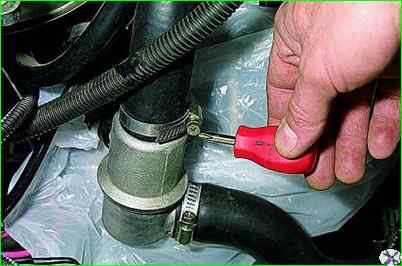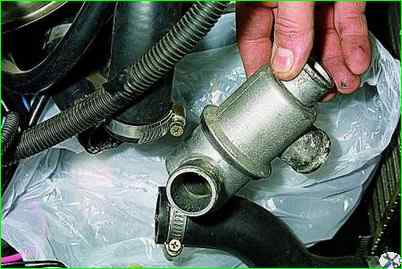The thermostat with a solid heat-sensitive filler has a main and bypass valve
Begins opening of the main valve at a coolant temperature of 79–82 °C, the stroke of the main valve is at least 6 mm.
On a cold engine, the thermostat valve closes the pipe leading to the radiator, and the liquid circulates only in a small circle (through the thermostat bypass pipe), bypassing the radiator.
The small circle includes the heater radiator, intake manifold, carburetor heating unit (on engine 21213) or throttle assembly (on engine 21214).
At a temperature of 78–85°C, the valve begins to move, opening the main pipe; in this case, part of the liquid circulates in a large circle through the radiator.
At a temperature of about 90°C, the main valve opens completely, and the bypass valve closes, and all the liquid circulates through the engine radiator.
The stroke of the main valve must be at least 6.0 mm.
You can evaluate the serviceability of the thermostat by heating the lower radiator pipe: it should be cold until the liquid temperature (according to the indicator) reaches 80–85°C, and hot when it rises to 85–90°C.
The thermostat is beyond repair. In case of malfunction, loss of tightness, or deformation of the pipes, it is replaced.

Thermostat: 1 - inlet pipe (from the engine); 2 - bypass valve; 3 - bypass valve spring; 4 - glass; 5 - rubber insert; 6 - outlet pipe; 7 - main valve spring; 8 - main valve seat; 9 - main valve; 10 - holder; 11 - adjusting nut; 12 - piston; 13 - inlet pipe (from the radiator); 14 - filler; 15 - clip; D - fluid inlet from the engine; P - fluid inlet from the radiator; H - liquid outlet to the pump
Removing and checking the thermostat
Thermostat malfunction can be checked without dismantling it.
If the thermostat is working properly, after starting a cold engine, the outlet (lower) radiator hose should remain cold for some time, and then quickly heat up, indicating the start of coolant circulation in a large circle.
To dismantle the thermostat, drain the coolant (see Replacing the coolant).
Coolant entering the generator disables it.

To prevent any remaining coolant from getting on the generator, cover it with plastic wrap.

Loosen the clamps of the fluid supply hose to the pump, the thermostat bypass hose, and the radiator outlet hose.

Having disconnected the hoses, remove the thermostat
To check the thermostat, lower it into a vessel with coolant, heat the vessel and use a thermometer to control the beginning of the opening of the main valve
Install the thermostat in reverse order.





